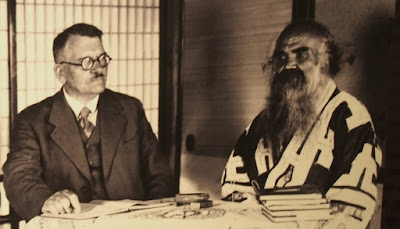 |
| Neil Munro (left) with an Ainu. |
In 1905 he became a naturalized Japanese citizen, adopting the katakana characters マンロー (man-ro-), and subsequently the Chinese (Kanji) characters ('full,' 'long-awaited,' 'satisfaction') 郎 (often used in names given to first-born sons; also 'official title'). His earlier seals show the Chinese characters 卍 樓 (man-ro-), which he probably changed as it became associated with German National Socialism.
From 1892 to 1898 he worked at the Yokohama General Hospital. In 1895 he married his first wife (of four), Adele Retz, a German with whom he had two sons. His wife died in 1905, and that same year Munro married a Japanese wife Toku Takabatake. They had a daughter but divorced in 1909. In 1914 Munro married Adele Favre-Brandt, a lady of Swiss and Japanese heritage, although he again divorced in 1937 to marry his fourth wife, Chiyo Kimura, a Japanese nurse, who assisted Munro in his medical practice. They remained married until his death in 1942. She died in 1974.
While working as a doctor, Munro became interested in archaeology and personally directed or participated in hundreds of excavations throughout Japan, and collected thousands of artefacts from the Jomon period and subsequent eras.
His work established that the Ainu were the indigenousness people of Japan. Munro excavated at Mitsuzawa, Omori in Tokyo, Negishi near Yokohama, and sites in Nagano prefecture, Kagoshima prefecture, and the Northern island of Hokkaido. In 1908 he published a book Prehistoric Japan, giving an account of his research and findings.
By 1923 Munro had amassed a great deal of material, but lost most of his books, artefacts, letters, and almost all his personal belongings in the Great Kanto Earthquake, which struck that year. Munro also spent a great deal of effort treating the victims of the fire and the earthquake for free. In 1932, he experienced a similar personal disaster, when his accommodation in Hokkaido was destroyed in a blaze. Luckily, he also regularly sent archaeological finds back to the UK, starting in 1894. The National Museum of Scotland has a large collection of artefacts sent by Munro.
He spent his life after 1930 in Nibutani in Hokkaido, although he had often visited the island before. There he documented the culture, language, folklore, traditions, and artefacts of the Ainu people, and also provided cheap or free health care for the local people. He was able to fund this by treating rich foreign patients at the Karuizawa Sanatorium in Nagano prefecture during the Summer. He worked there from 1923 and became a director in 1930.
Munro was also important in studying the health and illness patterns of Japanese people, and earned a doctorate in 1909 from Edinburgh University with a thesis entitled "Cancer in Japan," in which he noted that people in Nara had a much higher rate of cancer than those in Yokohama. Ironically, it was also this disease that finally killed in 1942, at a time when the land of his birth was at war with the land of his adoption.

0 comments:
Post a Comment